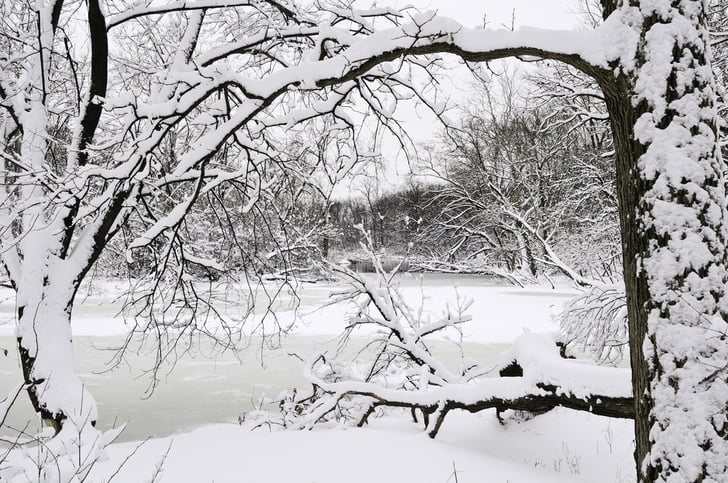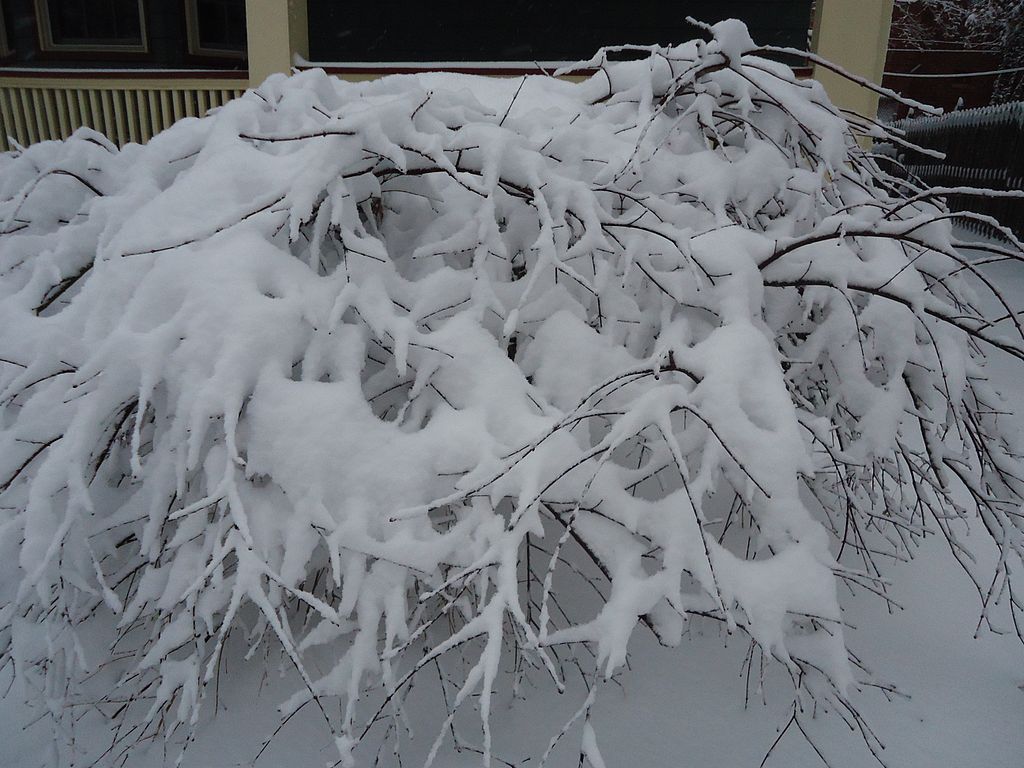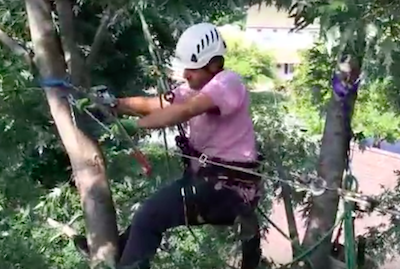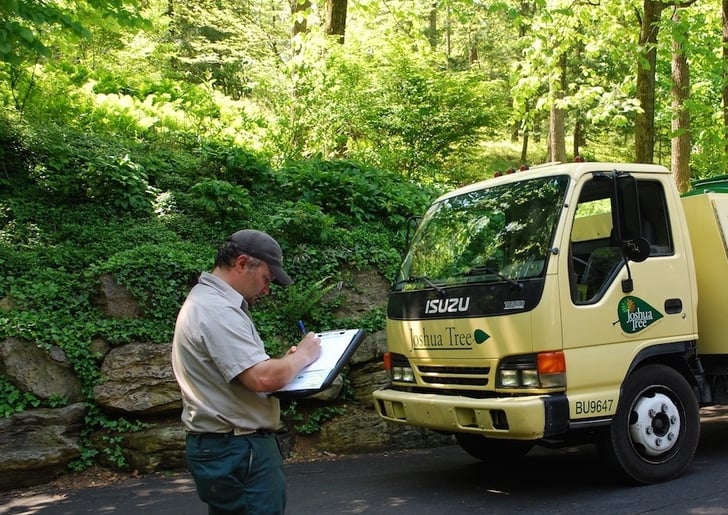Every season poses its own unique set of challenges to the landscape and the winter is no different.
The harsh winter conditions like wind, snow, and ice…along with our ways of dealing with those conditions (deicing products and snow plowing), can take a toll on the landscape. Winter injury to trees and shrubs can be a legitimate concern that homeowners want to address.
Come spring, it can be frustrating after a long winter to see any damage that might have occurred during the winter. It can start the springtime season off on the wrong foot.
In this article, we’ll talk about winter plant damage and how it can be prevented. We know that you care about protecting your landscape, no matter what the season.
Addressing and Preventing Cold Damage on Plants
It’s important to know that some trees and shrubs tend to be more vulnerable to cold-weather conditions than others. Cold damage on plants can be a real concern when temperatures drop below the freezing mark.
While some trees and shrubs can handle this, others will suffer.

Evergreen trees and shrubs tend to be particularly susceptible to cold damage. When the ground is frozen, the roots cannot take up water. Trees then try to use the water stored in their leaves. This can eventually lead to dehydration.
When it comes to preventing this, a good winter tree protection strategy is the application of an anti-desiccant spray on a warm winter day. This will create a protective coating that will prevent the leaves from losing extra water via evaporation. As a result, it saves every last drop for the plant.
A Certified Arborist can let you know which trees and shrubs would most benefit from an anti-desiccant spray.
Addressing and Preventing Winter Injury to Trees and Shrubs Due to Snow and Ice
Another serious problem that can lead to winter plant damage is snow and ice. Snow-bent and ice-damaged trees can be a huge source of frustration.
Certain species of trees and shrubs can be more susceptible to injury based on their size and shape. Evergreen shrubs, like Arborvitae for instance, are known to become damaged by the weight of snow or ice piling on them.
Similarly, trees like Poplars, Willows, and Elms have more brittle wood and are a bit more likely to fail due to a heavy snow or ice load.

Of course, with enough snow or ice piling up, any species of tree or shrub could ultimately have damage. There are also high winds to consider. Since many winter storms are accompanied by wind, this can put even more stress on a tree or shrub that is already piled with snow or ice.
Ideally, you want to avoid winter injury to trees and shrubs by taking proactive measures BEFORE a storm. Protecting trees and shrubs from snow and ice damage can be achieved with proper pruning. Trees, in particular, can be pruned so that any defects or weak branches are removed allowing your trees to have better chances of withstanding snow, ice, and wind.
During a storm, you can also take care to knock snow off of plants as it piles up. This is only something that we would recommend for smaller shrubs. We would NEVER advise you to stand on a ladder or put yourself at risk to remove snow. This can be incredibly dangerous and we caution strongly against it.
As for your smaller shrubs, going out and shaking them off every few hours can prevent snow build-up. Do your best to carefully brush off as much as possible. When you get your shrubs and ornamental trees as cleared from snow as possible, they’ll dry out quickly once the sun starts shining and the snow stops falling.
While we definitely recommend brushing off snow, ice is a different story. If your trees or shrubs are coated with ice, it is best to leave them alone. You can actually end up doing more harm than good trying to knock the ice off of a plant. We find that people end up breaking branches when they do this.
In many cases, the ice is going to just melt off when things warm up. But you can go around and look for damage following a heavy ice storm.
Addressing and Preventing Winter Injury to Trees and Shrubs Caused by Snow and Ice Removal
As we mentioned at the start of this article, it’s not just the snow and ice itself that can lead to problems.
Efforts to remove snow and ice can also lead to plant trouble. While you obviously need to clear your pathways and driveway, you definitely want to exercise some caution around your landscape.
Deicing products that help keep your hardscaping ice-free can be very harmful to plants.
When you are shopping for deicing products, we recommend looking for products that are plant- and pet-friendly. While these products might cost a little more than traditional salt- and chemical-based products, they can ultimately save you money by not having to replace damaged trees and shrubs.
Similarly, the snow plow can also end up damaging plants if you have them near your driveway or even the road. Protecting trees and shrubs in winter from snow plow damage is all about planning ahead and marking areas that need to be protected.
If your smaller shrubs are planted in a place where they are continually going to get buried, you might be better off moving them in the spring.
When the Damage is Done
If you’ve found this article and you’ve already experienced winter plant damage, you might be wondering what to do.
Here are a few things to keep in mind.
Damage to Large Trees
First and foremost, any time that you have risky storm damage to a tree, it’s best to have the tree evaluated by a professional. For instance, a hanging limb that could potentially fall is not worth messing around with on your own. A tree that is now leaning after a storm could also pose a big risk.
Keep in mind that storm damage isn’t always overtly noticeable. Sometimes storms damage trees in ways that make them structurally weak but may not be as noticeable as a hanging limb. Damage like cracks in the trunk or limbs or a root injury can still be serious.

Sometimes, repairing storm damage to trees can be addressed simply by removing the damaged limb (or limbs). This would mean cutting back to the next lateral or to the trunk of the tree if necessary. Pruning of any small, broken branches is also important. Disease and pests can begin to infest a tree that has open “wounds.” Pruning will help the tree to heal faster.
But in other cases, tree removal might be the best and safest option. A Certified Arborist can assess storm damage and determine if it poses any serious risk.
Sometimes, we can use tree cabling and bracing to address damage without having to remove the tree. With tree cabling, specialized hardware including bolts and cables are installed in the upper canopy of trees to help reduce the chance of splitting or cracking. These cables will need to be adjusted or replaced as your tree grows.
If a tree trunk has already begun to split, bracing can be used. This involves using rods, washers, and bolts to support the trunk and slow the process of splitting.
Damage to Shrubs
Smaller shrubs can also be damaged by snow or ice. Shrubs that had ice or snow piled on them for a long period can become misshaped or droopy. This is why it’s important to try and knock that snow off when you can.
With misshapen shrubs, you can generally try to re-shape them with pruning and branch tying. Tying branches together can help temporarily fill in unsightly gaps that are a huge eyesore. It can also help give some shape back to the shrub.

Sometimes stakes can also be used to help a droopy shrub stand up more straight.
Keep in mind that shrubs should not remain “tied” for too long as this can lead to damage.
Partnering with a Pro to Prevent and Address Winter Injury to Trees and Shrubs
When it comes to something as important as both the beauty and the safety of your property, you can accept nothing less than the best.
Whether you have already experienced winter plant damage or you’re looking to prevent it, you want to have a professional on your side who can help.
At Joshua Tree Experts, we can provide services that help with cold weather plant protection. We can also help assist you with any trees or shrubs that were damaged in a storm. Plus, we are always available to provide advice and guidance when you have questions and concerns.
When you partner with a pro, you can help set yourself up for the most success, even in the harshest of conditions.
If you’d like to have a tree on your property assessed, contact us for a free consultation. Then you can rest assured knowing that we’ve got it completely under control.
Image Source | snow covered shrub, tree in winter




